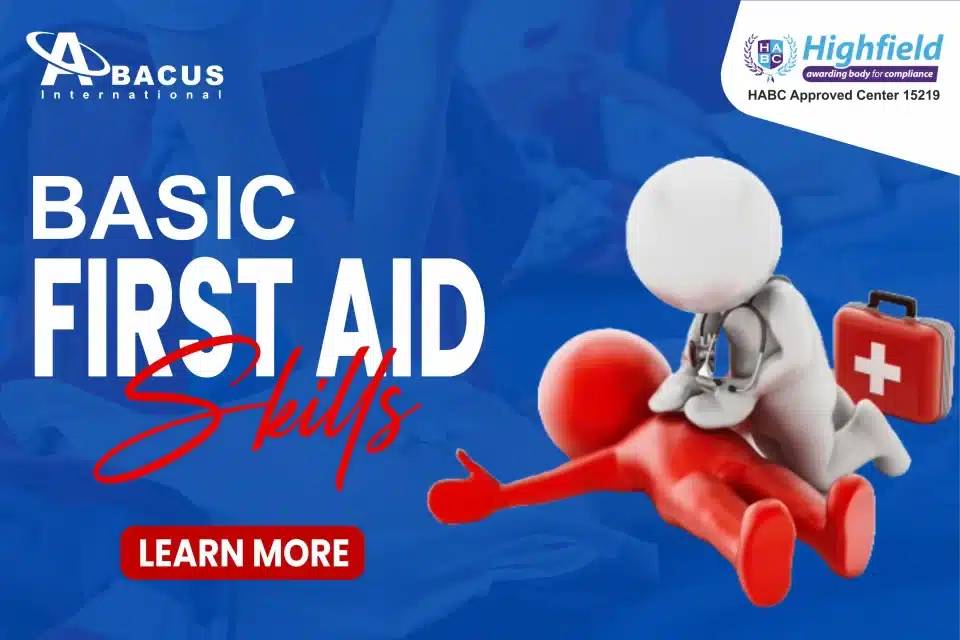In everyday life, unexpected emergencies can arise and need immediate action; having a basic knowledge of first aid is important for everyone. Knowing how to respond can make a difference from minor injuries to life-threatening situations. By learning these simple techniques, you’ll be better prepared to handle emergencies confidently and save lives.
Basic first aid skills:
- CPR (Cardiopulmonary Resuscitation)
- Heimlich Maneuver
- Setting a Splint
- Stopping Bleeding
- Treating Burns
- Seizures
- Head trauma and Concussions
- Stitches
- Shock
- Sprains
1. CPR (Cardiopulmonary Resuscitation)
CPR stands for Cardiopulmonary Resuscitation; it is a life-saving technique used in emergencies where someone’s breathing or heartbeat has stopped. Rescue breathing and chest compressions are used to maintain the flow of oxygenated blood to the vital organs. It provides artificial ventilation that can maintain a person’s breathing, blood flow, and brain function until professional medical help arrives.
How to perform CPR:
- If a person is not responding, call 911 and ensure the scene is safe.
- Lay the person on their back and open the airways by tilting their head back slightly by lifting their chin.
- CPR chest compressions must be performed 100–120 times per minute.
- Provide two rescue breaths.
- Repeat until an ambulance or professional help arrives.
2. Heimlich Maneuver
If someone is choking, the Heimlich maneuver can remove whatever is blocking their airways to save their life or prevent potential brain damage. Usually, after having their airways cut off a person has 5 minutes before brain damage occurs.
How to perform the Heimlich maneuver:
- Place your arms over the choke person’s waist while standing behind them.
- Make a fist with one hand and place it above the belly button but below the ribs.
- Grab your fist with your other hand and press into their abdomen with quick, upward pushes.
- Keep doing this until the object comes out or they can breathe again.
- Lower the person to the ground and provide CPR if they’re unconscious.
3. Setting a Splint
Splinting is a technique used to immobilize and support an injured body part to prevent further damage and reduce pain.
How to apply a Splint:
- First, examine the injury, perform manual stabilization, and stop any bleeding.
- Assess distal pulse and motor and sensory function, place something soft like cloth or gauze between the limb and the splint.
- Position the splint along the injured area, covering joints above and below.
- Use bandages or tape to keep the splint in place, not too tight.
- Finally, check if the person can feel and move below the injury after applying the splint.
4. Stopping Bleeding
When someone is bleeding a lot, it’s important to stop the bleeding. This helps prevent too much blood loss, which can cause shock and other problems.
How to Stop Bleeding:
- Using a sterile bandage or a clean towel, apply pressure directly to the wound.
- Raise the injured limb above the level of the heart.
- If bleeding continues, apply additional layers of dressing and continue applying pressure.
- Use a tourniquet if nothing else works to stop the bleeding.
- Get medical help immediately if bleeding is severe or can’t be stopped.
5. Treating Burns
Burns can occur from heat, chemicals, electricity, or radiation and require quick first aid to minimize damage and relieve pain.
How to treat burns:
- Remove the source of the burn if it’s safe, and put the affected area under cool running water for 10 to 20 minutes.
- Use a clean cloth or a sterile, non-adhesive dressing to cover the burn.
- Avoid breaking any blisters that may have formed.
- Get medical help if the burn is serious, on sensitive spots, or if the person seems shocked or has trouble breathing.
6. Seizures
Seizures can be frightening to witness but knowing how to respond can help keep the person safe until it’s over.
How to stop Seizures:
- Stay calm and ensure the person’s safety by clearing nearby objects that might hurt them.
- Help the person lie down on the ground and place something soft under their head.
- Do not hold the person down or put anything into their mouth.
- Time the seizure and observe any strange movements or behaviors.
- After the seizure ends, gently turn them on their side to help them breathe.
- Stay with the person until they are fully awake or until medical help arrives if necessary.
7. Head Trauma and Concussions
Head injuries, including concussions, are dangerous and require medical attention. If left untreated, a concussion can have long-term effects on the brain.
How to prevent Head Trauma and Concussion:
- Observe any changes in the person’s behavior or symptoms, such as confusion, dizziness, or memory loss.
- Apply something cold to the injured area to reduce pain and swelling.
- Check the behavior or symptoms of a person, such as a headache, feeling sick, or difficulty with balance.
- Advise them to avoid activities that worsen their condition, such as exercising or screen time.
- If they have bad symptoms or might have a serious head injury, get medical help immediately.
8. Stitches
It could be necessary for you to bandage a wound before medical assistance arrives. Even if this is a rare situation, it’s necessary to know how to apply stitch, safely and properly.
How to apply Stitches:
- Clean the wound and surrounding area thoroughly, use sterile gloves to prevent infection.
- Pull the edges of the wound together gently, and use medical sutures to close the wound.
- Apply pressure to stop any bleeding, keep the wound clean and dry while it heals
- Observer for signs of infection, such as redness or swelling.
- Seek medical help if there are any concerns or difficulties.
9. Shock
Lack of oxygenated blood to the body’s tissues and organs can result in shock, a life-threatening condition. Recognize the signs of shock, including pale or clammy skin, rapid heartbeat, and shallow breathing.
How to treat shock:
- Lay the person down and lift their legs to help blood flow to important organs.
- Keep the person warm and comfortable, covering them with a blanket if available.
- Monitor the person’s vital signs, such as pulse and breathing while you wait for medical help.
- If they vomit or get worse, turn them onto their side to prevent them from choking.
10. Sprains
Sprains happen when ligaments get stretched or torn, often from sudden twisting or hitting something. They’re usually not life-threatening, but they can hurt a lot and make it hard to move.
How to heal Sprains:
- Avoid putting weight on the injured limb and give it some rest.
- Apply ice wrapped in a cloth to reduce swelling and pain. Apply for 15-20 minutes every 2-3 hours for the first 48 hours.
- Wrap the hurt area with an elastic bandage to reduce swelling and give support.
- Raise the hurt limb above the heart if you can lower swelling even more.
- Advise the person to rest and avoid hard activity until the sprain has healed.

